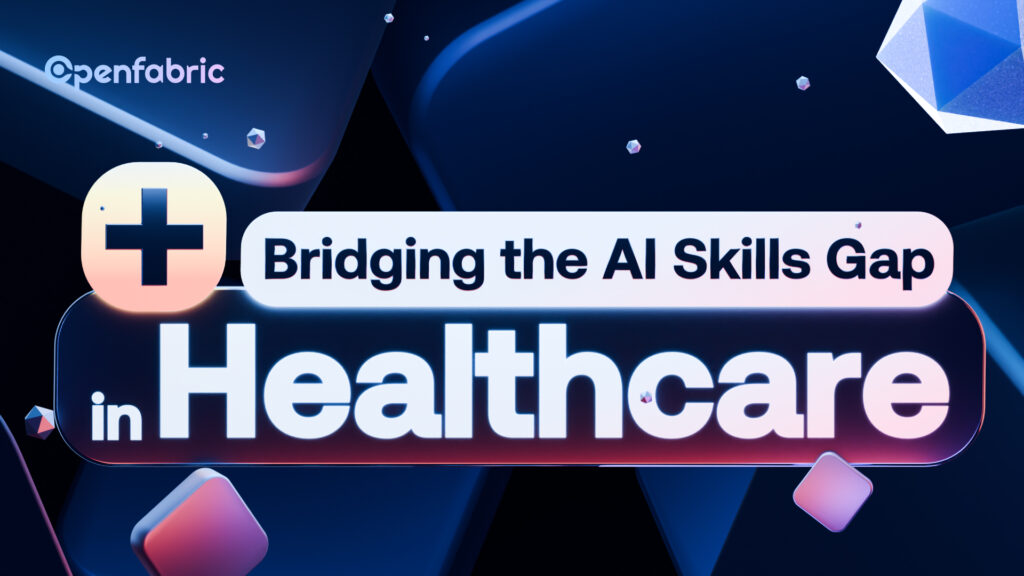
May 23, 2025 6 minutes read
Bridging the AI Skills Gap in Healthcare

The advent of artificial intelligence transformed many industries including the healthcare industry. However, healthcare is a delicate sector that needs to be approached very carefully because the smallest mistake could be fatal. Therefore, the applications of AI have not found wide adoption in the healthcare industry compared to other sectors that have more or less gone fully AI. This has caused a wide AI skills gap in healthcare that when bridged would greatly improve the care and outcome of a patient.
Nowadays, AI is used more in the healthcare industry. The gap in AI skills in this sector primarily exists due to the relatively slower adoption of AI in healthcare in comparison to other industries. In other industries, AI has been optimized to fully function in the industry with minimal supervision from professionals in that industry. In the healthcare industry, the functions of AI extend only to basic functions.
AI is evolving every day, and soon its use in healthcare will extend well beyond the basics. Therefore, there is every need to bridge the AI skills gap in healthcare which exists among both healthcare workers and patients.
In this article, we will discuss relevant strategies that can be employed to bridge the AI skills gap in healthcare among patients and healthcare workers.
Let’s dive in!
Benefits of AI in healthcare
Artificial Intelligence creates numerous opportunities allowing for a better and more reliable system for both workers and patients alike. Here are some of the benefits of AI in health care:
Enhanced diagnosis
The service of healthcare mostly involves the diagnosis and treatment of diseases. However, the unassisted processes for diagnosis further prolong the commencement of treatment, which either prolongs the patient’s pain or reduces their chance of getting better. Once the symptoms of a disease start and a patient goes to the hospital, every second counts. With AI-assisted disease diagnosis, prompt care can be given to a patient.
In addition, AI-assisted diagnosis ensures an accurate diagnosis. This is because the AI system is trained using millions or billions of data and patterns, in terms of signs and symptoms, that are characteristic of specific disease conditions. As such, even the slightest deviation would still be accurately diagnosed with AI-assisted diagnosis and we all know that accurate diagnosis is the first step to an effective treatment plan.
Increase in the effectiveness of treatment.
AI doesn’t just stop at diagnosing. It can also assist in formulating treatment plans or options best suited for that disease condition. In addition, it tailors the plan to fit the biodata of the patient. In medicine, there are numerous drugs that can be used for the treatment of a particular disease. The choice of these drugs for a particular treatment plan takes into consideration the physical state of the patient. Certain drugs are suitable for an age group, and other people may be allergic to some common medications.
AI puts all these factors into consideration ensuring that patients get the most suitable treatment option. It optimizes the treatment options for the patient, thereby increasing the effectiveness of treatment and ultimately reducing the occurrence of relapse or reinfection of a disease.
Faster dispensation of health care service
It is not an uncommon sight to find long waiting lines in emergency rooms of hospitals. This leads to a delay in delivering health care services to patients. AI makes it possible for patients to access basic healthcare services from the comfort of their homes. AI tools that are made for patient care carefully consider the patient’s symptoms and tell them what to do. In a scenario where the patient needs to see a doctor for more examination, the AI tool helps to make an appointment with an available doctor.
This whole process widens the reach of health care services from competent doctors to patients, wherever they are. When the need to see a doctor arises, it is orderly and reduces waiting time by a great amount.
Practice before implementation
AI can help surgeons simulate surgical scenarios which allows them to practice before the surgery. This allows surgeons to prepare for any possible complications during the surgery. As such, even the most complex surgeries can have excellent outcomes.
These few benefits and more highlight why there should be more utilization of AI in the system, and this can only be achieved if the AI skills gap in healthcare is eliminated.
How can the AI skills gap in healthcare be bridged?
Receptiveness of healthcare workers towards AI
Nowadays, everyone thinks that AI has come to steal our jobs. This is entirely untrue. What AI does is enhance your efficiency as a professional. Healthcare workers must be made aware of the numerous benefits of AI in enhancing patient care. As a healthcare worker, it helps you dispense more accurate care, increasing your effectiveness.
A meta-analysis estimated that the rate of depression among physicians is about 29%. For non-physicians, this rate is 9%. Often depression is associated with the long hours of work, coupled with other physically demanding aspects of the job. With artificial intelligence, physicians would not have to deal with the excessive burn-out that comes with the job terrain.
To first bridge the AI skills gap in healthcare, healthcare workers must be willing to trust AI systems to assist them with patient care.
Technical training and assistance
Artificial intelligence is a field of technology that is foreign to many healthcare workers. However, with the incorporation of generative AI tools into our devices, almost everyone with a smart device knows about AI. Still, there are specific AI tools that are best suited in the setting of a health facility. These tools are specialized for diagnosis, treatment, and general patient care. As such, they are used differently from the regular AI tools.
Therefore, training should be organized to teach healthcare workers how to use these tools for the results they need to assist with their jobs as healthcare workers.
Development of user-friendly AI tools
User-friendly AI tools allow for easy navigation by the user. Many of these tools even have on-screen instructions and help centers that answer users’ questions whenever they hit a snag. In addition, these tools have clear navigation icons that execute the exact action they are meant to do.
Openfabric tools relevant to the healthcare industry
Openfabric highlights the importance of human welfare by creating these tools that aid healthcare workers in the accurate and prompt delivery of care to patients. These tools are built on a decentralized system, and as such, address the issue of data privacy that is of utmost importance when it comes to patients’ privacy.
How do they help bridge the AI skills gap in healthcare?
Often, the value of something is found in the problems it solves directly or indirectly. These tools facilitate prompt diagnosis and, therefore, treatment of patients. By doing so, they help reduce the extreme burnout physicians face. However, if it is meant to simplify a job process but using it feels like another job, then its aim is lost. That is why these tools are user-friendly. They provide users with clear instructions on where to go, what to do, and how to achieve the best results.
Examples of these tools include:
- Openfabric AI genome generator
- Openfabric drug discovery tool
- Radiology assistant
- DNA visualizer
These tools usher in a new outlook toward comprehensive patient care, and you can find them all in our marketplace when you visit our website.
Conclusion
Implementing AI in our healthcare systems is a progressive move that aims to take patient care to a new level. However, the health professionals in charge also have to be kept abreast of these latest developments for the entire process to be fully effective. Remember that AI is just an assistant. Therefore, it is important to know the limitations of these tools as it would ensure that they are utilized better and correctly.
For more insights, visit our WEBSITE today!

